Multi-Frequency Based Direction-of-Arrival Estimation for 2q-Level Nested Radar & Sonar Arrays
Abstract
:1. Introduction
2. 2qth-Order Cumulant, 2qth-Order Difference Co-Array and 2q-Level Nested Array
2.1. 2qth-Order Cumulant Matrix
2.2. 2qth-Order Difference Co-Array
2.3. 2q-Level Nested Array
3. Multi-Frequency Method and Its Application in a 2q-Level Nested Array
3.1. The Multi-Frequency Method for Minimum Frequency Seperation (MFMFS)
| Algorithm 1. Summary of the Multi-Frequency Method for Minimum Frequency Separation (MFMFS). |
| Input: Receive signal sequence of the 2q-level nested array from D sources. Output: The optimized cumulant vector . |
|
3.2. The Multi-Frequency Method for a Minimum Number of Frequencies (MFMNF)
| Algorithm 2. Summary of the Multi-Frequency Method for a Minimum Number of Frequencies (MFMNF). |
| Input: Receive signal sequence of the 2q-level nested array from D sources Output: The optimized cumulant vector . |
|
3.3. Spatial Smoothing Based Algorithm for the Multi-Frequency 2q-Level Nested Array
3.4. Discussions on the Computational Complexity and Cramér–Rao Bound
3.4.1. Computational Complexity
3.4.2. Cramér–Rao Bound
4. Simulation
4.1. Simulation 1
4.2. Simulation 2
4.3. Simulation 3
5. Conclusions
Author Contributions
Funding
Acknowledgments
Conflicts of Interest
References
- Tuncer, T.E.; Friedlander, B. Classical and Modern Direction-of Arrival Estimation; Elsevier: Boston, MA, USA, 2009. [Google Scholar]
- Ruf, C.S. Numerical annealing of low-redundancy linear arrays. IEEE Trans. Antennas Propag. 1993, 41, 85–90. [Google Scholar] [CrossRef]
- Moffet, A. Minimum-redundancy linear arrays. IEEE Trans. Antennas Propag. 1968, 16, 172–175. [Google Scholar] [CrossRef] [Green Version]
- Bloom, G.S.; Golomb, S.W. Application of numbered undirected graphs. Proc. IEEE 1977, 65, 562–570. [Google Scholar] [CrossRef]
- Rossi, M.; Haimovich, A.M.; Eldar, Y.C. Spatial compressive sensing in MIMO radar with random arrays. In Proceedings of the 46th Annual Conference on Information Sciences and Systems, Princeton, NJ, USA, 21–23 March 2012. [Google Scholar]
- Rossi, M.; Haimovich, A.M.; Eldar, Y.C. Spatial compressive sensing for MIMO radar. IEEE Trans. Signal Process. 2014, 62, 419–430. [Google Scholar] [CrossRef]
- Mishra, K.V.; Kahane, I.; Kaufmann, A.; Eldar, Y.C. High spatial resolution radar using thinned arrays. In Proceedings of the IEEE Radar Conference, Seattle, WA, USA, 8–12 May 2017. [Google Scholar]
- Pal, P.; Vaidyanathan, P.P. Nested arrays: A novel approach to array processing with enhanced degrees of freedom. IEEE Trans. Signal Process. 2010, 58, 4167–4181. [Google Scholar] [CrossRef]
- Zhou, C.; Gu, Y.; Fan, X.; Shi, Z.; Mao, G.; Zhang, Y.D. Direction-of-arrival estimation for coprime array via virtual array interpolation. IEEE Trans. Signal Process. 2018. [Google Scholar] [CrossRef]
- Shi, J.; Hu, G.; Zhang, X.; Sun, F.; Zhou, H. Sparsity-based two dimensional DOA estimation for co-prime array: From sum-difference co-array viewpoint. IEEE Trans. Signal Process. 2017, 65, 5591–5604. [Google Scholar] [CrossRef]
- BouDaher, E.; Ahmad, F.; Amin, M.G. Sparsity-based direction finding of coherent and uncorrelated targets using active nonuniform arrays. IEEE Signal Process. Lett. 2015, 22, 1628–1632. [Google Scholar] [CrossRef]
- Weng, C.C.; Vaidyanathan, P.P. Nonuniform sparse array design for active sensing. In Proceedings of the Conference Record of the Forty Fifth Asilomar Conference on Signals, Systems and Computers (ASILOMAR), Pacific Grove, CA, USA, 6–9 November 2011. [Google Scholar]
- Devaney, A.J.; Marengo, E.A.; Gruber, F.K. Time-reversal-based imaging and inverse scattering of multiply scattering point targets. J. Acoust. Soc. Am. 2005, 118, 3129–3138. [Google Scholar] [CrossRef]
- Shi, G.; Nehorai, A. Maximum likelihood estimation of point scatterers for computational time-reversal imaging. Commun. Inf. Syst. 2005, 5, 227–256. [Google Scholar] [CrossRef] [Green Version]
- Ciuonzo, D.; Salvo Rossi, P. Noncolocated time-reversal MUSIC: High-SNR distribution of null spectrum. IEEE Signal Process. Lett. 2017, 24, 397–401. [Google Scholar] [CrossRef]
- Ciuonzo, D.; Romano, G.; Solimene, R. Performance analysis of time-reversal MUSIC. IEEE Trans. Signal Process. 2015, 63, 2650–2662. [Google Scholar] [CrossRef]
- Dogan, M.C.; Mendel, J.M. Applications of cumulants to array processing Part I: Aperture extension and array calibration. IEEE Trans. Signal Process. 1995, 43, 1200–1216. [Google Scholar] [CrossRef]
- Porat, B.; Friedlander, B. Direction finding algorithms based on higher order statistics. IEEE Trans. Signal Process. 1991, 39, 2016–2024. [Google Scholar] [CrossRef]
- Birot, G.; Albera, L.; Chevalier, P. Sequential high-resolution direction finding from higher order statistics. IEEE Trans. Signal Process. 2010, 58, 4144–4155. [Google Scholar] [CrossRef] [Green Version]
- Pal, P.; Vaidyanathan, P.P. Multiple level nested array: An efficient geometry for 2qth order cumulant based array processing. IEEE Trans. Signal Process. 2012, 60, 1253–1269. [Google Scholar] [CrossRef]
- Mishra, K.V.; Kruger, A.; Krajewski, W.F. Compressed sensing applied to weather radar. In Proceedings of the IEEE Geoscience and Remote Sensing Symposium, Quebec City, QC, Canada, 13–18 July 2014; pp. 1832–1835. [Google Scholar] [CrossRef]
- Alinezhad, P.; Seydnejad, S.R.; Abbasi-Moghadam, D. DOA estimation in conformal arrays based on the nested array principles. Digit. Signal Process. 2016, 50, 191–202. [Google Scholar] [CrossRef]
- Iizuka, Y.; Ichige, K. Optimum linear array geometry with minimum redundancy for 2q-th order cumulant-based array processing. In Proceedings of the 4th International Workshop on Compressed Sensing Theory and Its Applications to Radar, Sonar and Remote Sensing (CoSeRa), Aachen, Germany, 19–22 September 2016; pp. 207–211. [Google Scholar] [CrossRef]
- Chen, T.; Guo, M.; Guo, L. A direct co-array interpolation approach for direction finding. Sensors 2017, 17, 2149. [Google Scholar] [CrossRef] [PubMed]
- Liu, H.; Zhao, L.; Li, Y.; Jing, X.; Truong, T.K. A sparse-based approach for DOA estimation and array calibration in uniform linear array. IEEE Sens. J. 2016, 16, 6018–6027. [Google Scholar] [CrossRef]
- Qin, S.; Zhang, Y.; Amin, M.G.; Himed, B. DOA estimation exploiting a uniform linear array with multiple co-prime frequencies. Signal Process. 2017, 130, 37–46. [Google Scholar] [CrossRef] [Green Version]
- Ciuonzo, D. On time-reversal imaging by statistical testing. IEEE Signal Process. Lett. 2017, 24, 1024–1028. [Google Scholar] [CrossRef]
- Moulton, J.L.; Kassam, S.A. Resolving more sources with multifrequency co-arrays in high-resolution direction-of-arrival estimation. In Proceedings of the 43rd Annual Conference on Information Sciences and Systems, Baltimore, MD, USA, 18–20 March 2009; pp. 772–777. [Google Scholar] [CrossRef]
- Boudaher, E.; Jia, Y.; Ahmad, F.; Amin, M.G. Multi-frequency co-prime arrays for high-resolution direction-of-arrival estimation. IEEE Trans. Signal Process. 2015, 63, 3797–3808. [Google Scholar] [CrossRef]
- Shi, J.; Hu, G.; Zhang, X. Direction of arrival estimation in low-grazing angle: A partial spatial-differencing approach. IEEE Access 2017, 5, 9973–9980. [Google Scholar] [CrossRef]
- Shi, J.; Hu, G.; Sun, F.; Zong, B.; Wang, X. Improved Spatial Differencing Scheme for 2-D DOA Estimation of Coherent Signals with Uniform Rectangular Arrays. Sensors 2017, 17, 1956. [Google Scholar] [CrossRef] [PubMed]
- Delmas, J.P.; Abeida, H. Cramer-Rao bounds of DOA estimates for BPSK and QPSK Modulated signals. IEEE Trans. Signal Process. 2006, 54, 117–126. [Google Scholar] [CrossRef]
- Delmas, J.P. Closed-form expressions of the exact Cramer–Rao bound for parameter estimation of BPSK, MSK, or QPSK waveforms. IEEE Signal Process. Lett. 2008, 15, 405–408. [Google Scholar] [CrossRef]
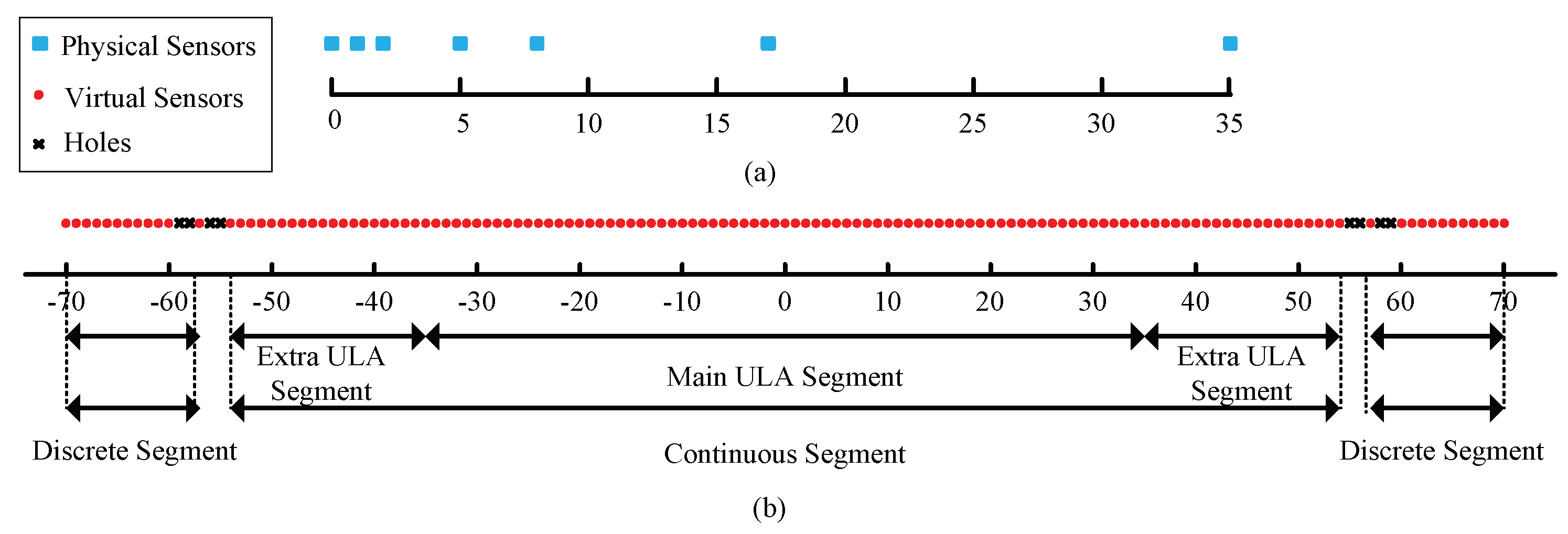
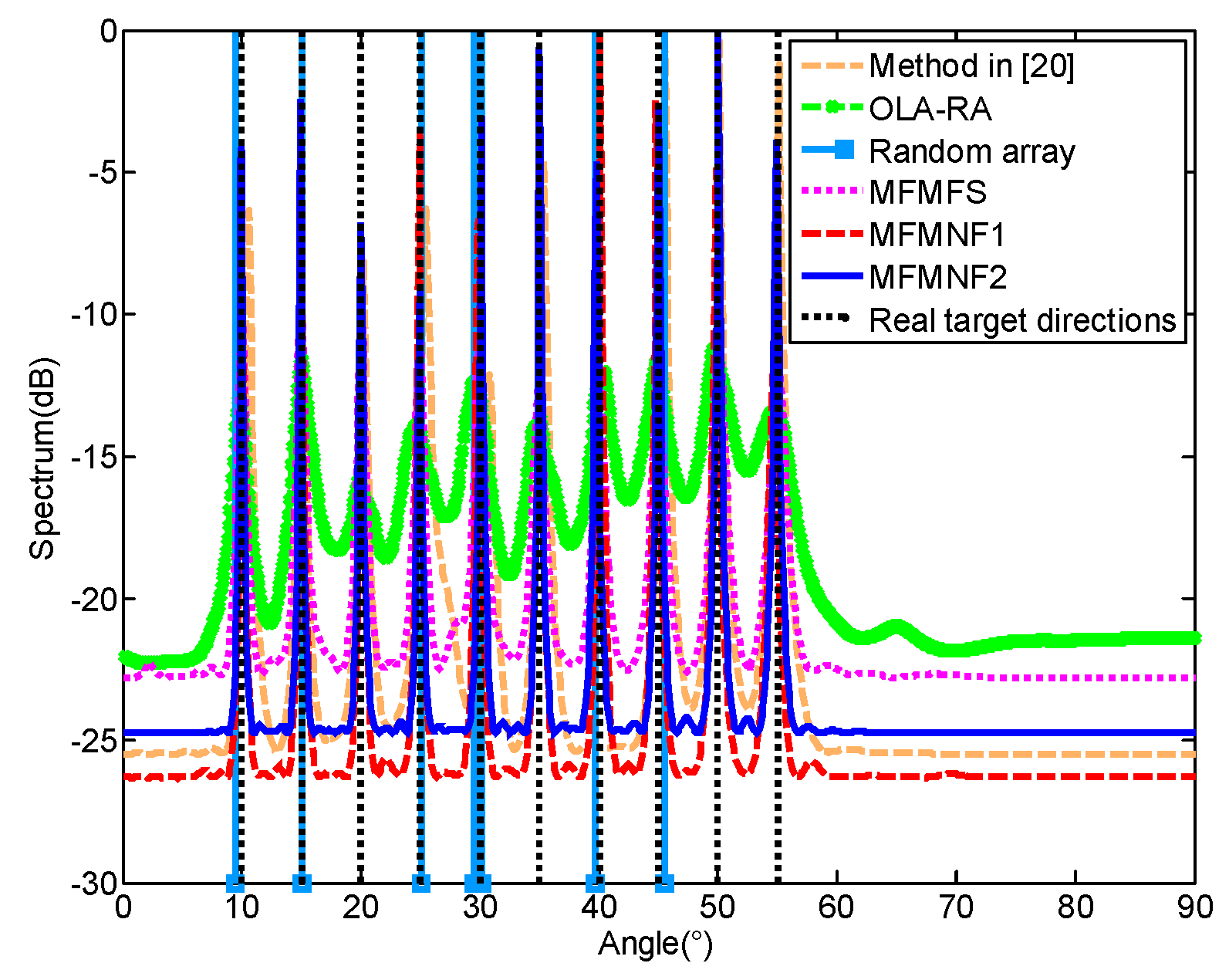

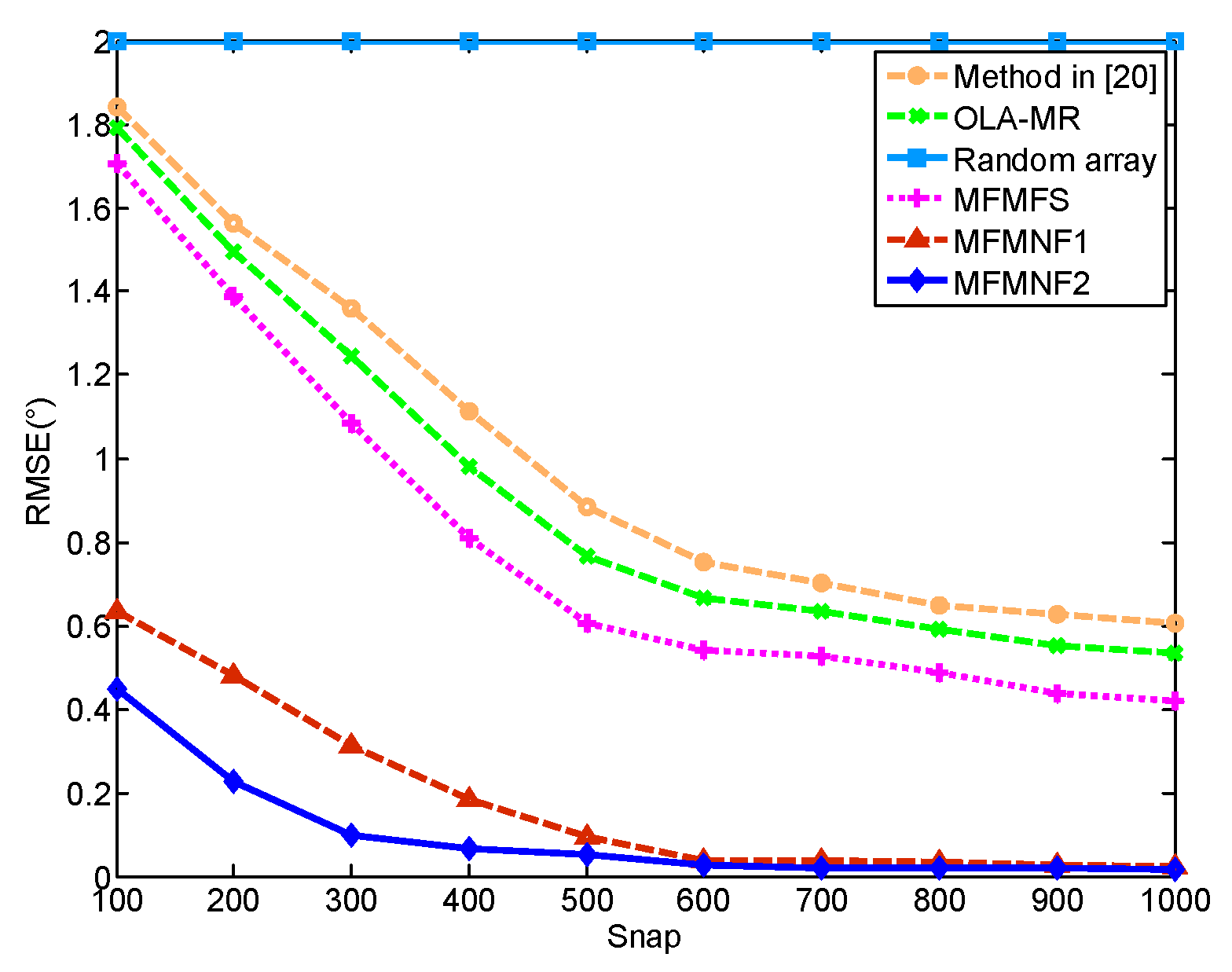

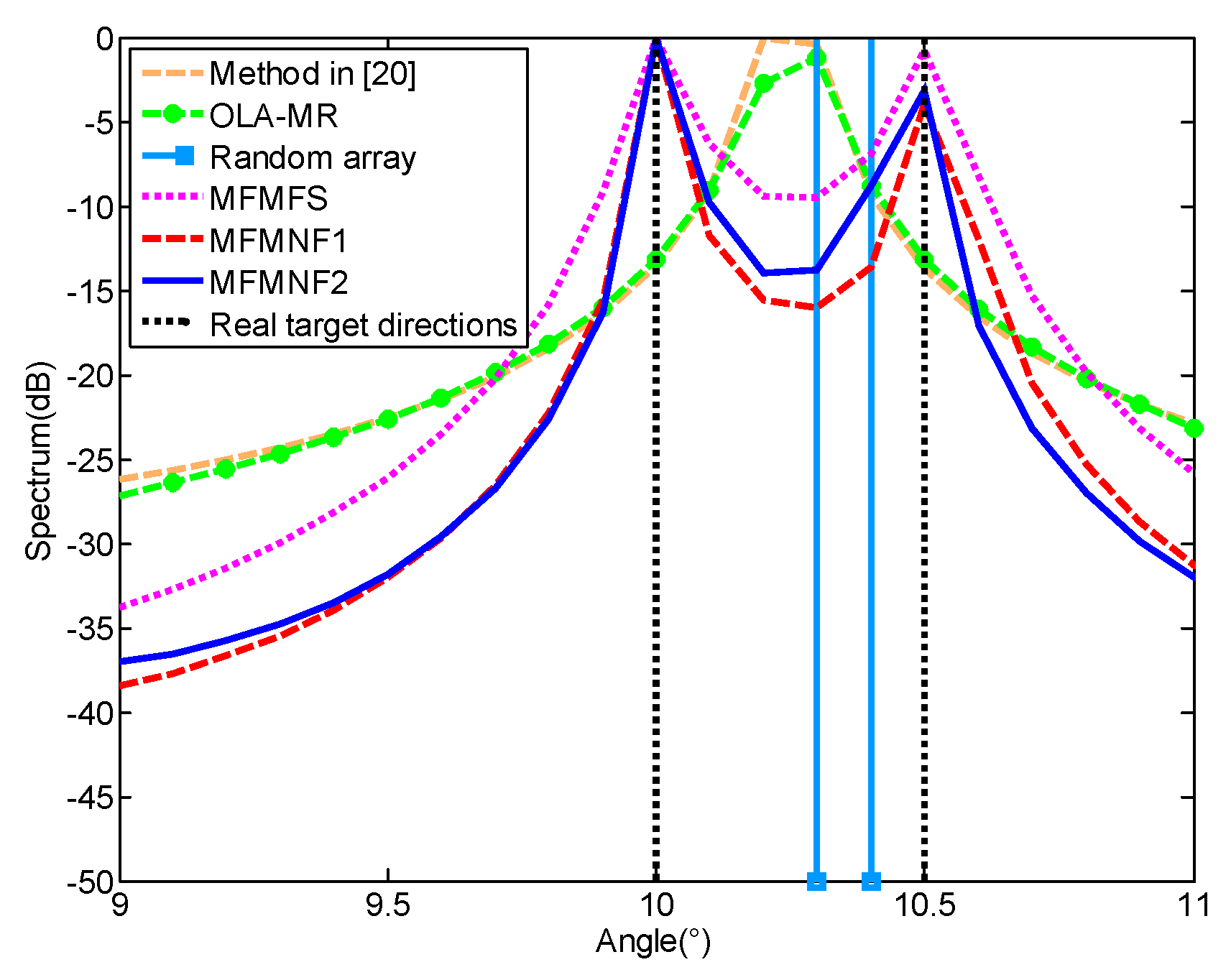

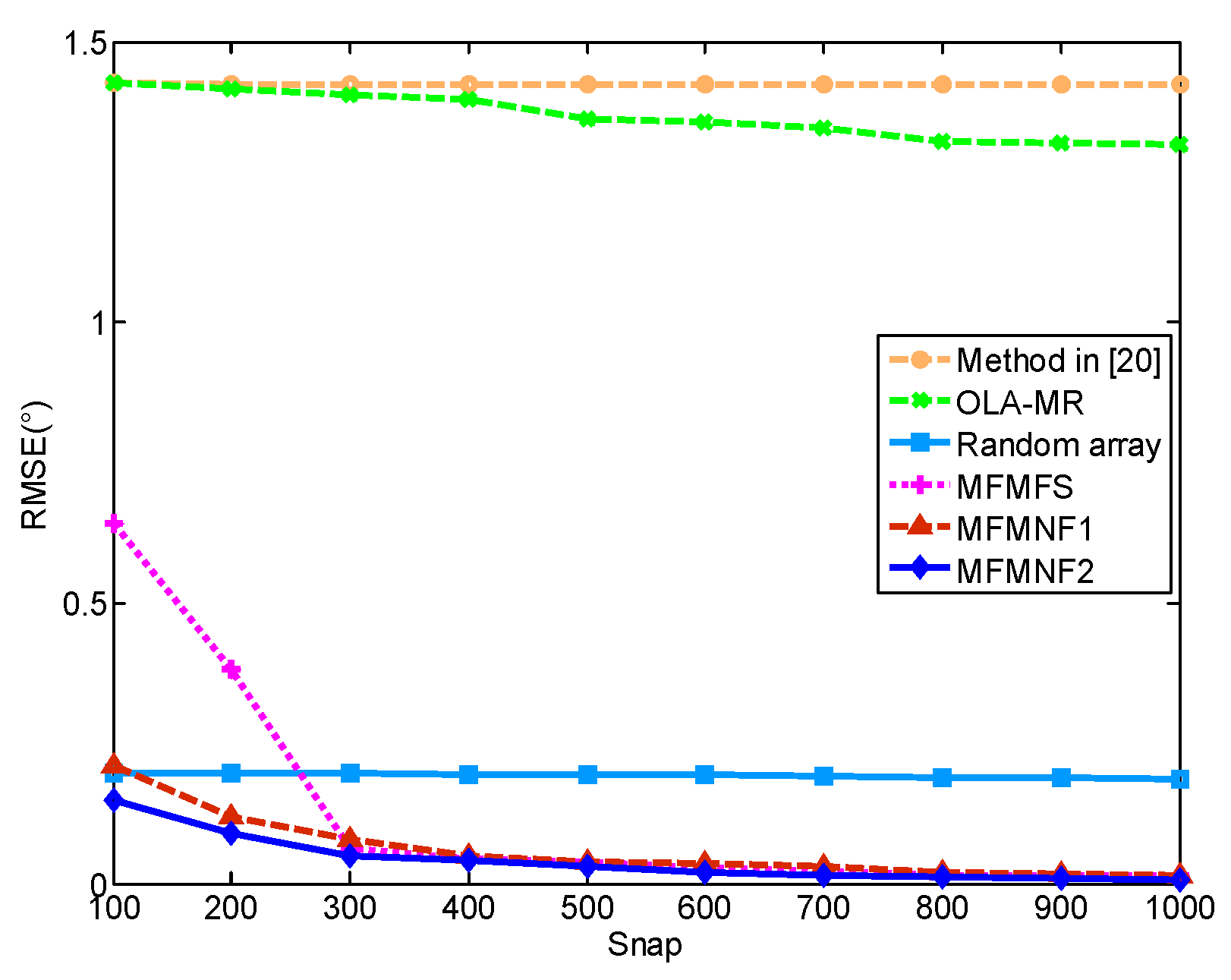
| Number of Physical Sensors | Random Array | MRA | 2q-Level Nested Array | OLA-MR in [23] | MFMFS | MFMNF1 | MFMNF2 | |
|---|---|---|---|---|---|---|---|---|
| 4 | 9 | 11 | 29 | 49 | 29 | 45 | 133 | 8 |
| 5 | 17 | 19 | 49 | 87 | 61 | 93 | 241 | 12 |
| 6 | 25 | 27 | 73 | 93 | 93 | 119 | 419 | 8 |
| 7 | 31 | 35 | 109 | 123 | 141 | 179 | 597 | 32 |
| 8 | 39 | 47 | 163 | 289 | 213 | 269 | 1049 | 18 |
© 2018 by the authors. Licensee MDPI, Basel, Switzerland. This article is an open access article distributed under the terms and conditions of the Creative Commons Attribution (CC BY) license (http://creativecommons.org/licenses/by/4.0/).
Share and Cite
Zhou, H.; Hu, G.; Shi, J.; Feng, Z. Multi-Frequency Based Direction-of-Arrival Estimation for 2q-Level Nested Radar & Sonar Arrays. Sensors 2018, 18, 3385. https://doi.org/10.3390/s18103385
Zhou H, Hu G, Shi J, Feng Z. Multi-Frequency Based Direction-of-Arrival Estimation for 2q-Level Nested Radar & Sonar Arrays. Sensors. 2018; 18(10):3385. https://doi.org/10.3390/s18103385
Chicago/Turabian StyleZhou, Hao, Guoping Hu, Junpeng Shi, and Ziang Feng. 2018. "Multi-Frequency Based Direction-of-Arrival Estimation for 2q-Level Nested Radar & Sonar Arrays" Sensors 18, no. 10: 3385. https://doi.org/10.3390/s18103385





